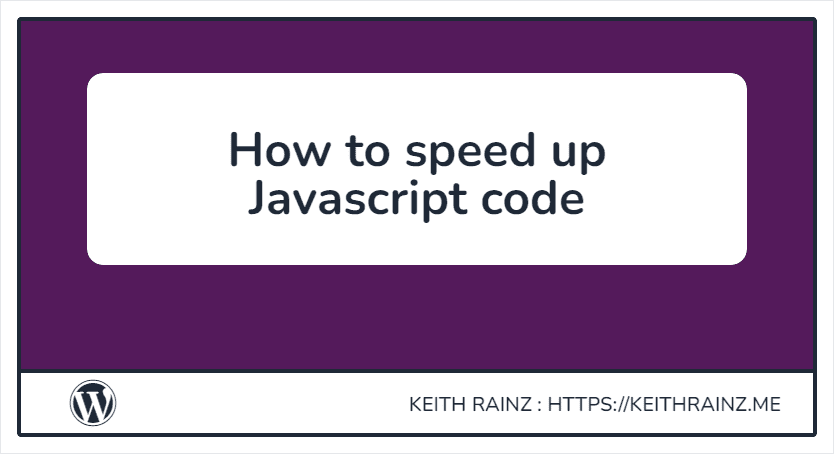Learn How to speed up Javascript code with these 8 steps. JavaScript is one of a web page’s three main languages. Although it is not needed, the functionality of most sites requires JavaScript. You can have on the market the best database hardware, but bad JavaScript software can be a bottleneck and slow down the load times of your page. Here are some tips to use basic JavaScript tweaks to speed up your page.
1. Manipulate Elements Before Adding Them to the DOM
The DOM is every item that includes HTML and its browser-printed information. Retrieving values from the DOM and modifying them based on user feedback is popular for developers. It may seem boring, but with DOM components stripped out it takes more time to modify values after you have already printed them to the DOM.
For example, if you have some content to print to a div component, use JavaScript as a string to make changes to the content and then print the string to the element. You through the JavaScript engine’s need to process HTML when operating with content factor.
2. Minify Your JavaScript Files
Formatting helps you to read code and understand its logic when you create JavaScript files. Any coder who has been through college is aware of the importance of syntax formatting to make learning easier. However, for storing files, the web server does not need such format characters. Through minifying them, you can reduce the size of JavaScript files.
Minifying is the process of removing different formatting characters from coding files, such as tabs and extra spaces. The file size reduced by several bytes saves time for uploading scripts from your clients. This phase is necessary for sites with several external scripts to be loaded for the website to function.
3. Use Caching
This rarely changes the JavaScript scripts. There is also an unusual switch in your CSS files. Caching the two only leaves the content on the downloadable page. You don’t have to think about caching if you use a CDN.
If possible, you should use a CDN. Many of JavaScript’s common libraries are on CDNs. Three examples of libraries available on common cloud hosts are JQuery, Bootstrap, and Angular. Just plug in the CDN URL and you don’t have to worry about storing files on your server anymore. CDNs dynamically store objects so that instead of shared resources, you can concentrate on your local code.
4. Place Script Includes at the Bottom of Your HTML Pages
When a web page is loaded by a browser, it loads it from top to bottom. Developers are used to placing CSS and JS links in a HTML page header section. After the opening of the HTML tag, this segment is usually placed at the top of the page, which means that the user first loads JS and CSS files and then loads the body tag material.
The seconds it takes for loading JS and CSS files make a difference in user engagement, particularly when loading multiple files before content. Because JS and CSS files do not display users any information, this traditional way of structuring HTML can affect the statistics of user engagement. You can place JS and CSS files below the body tag at the bottom of your pages.
It is important to note that in the same amount of time the page still loads, but its perceived speed is much faster. Users see content before loading JS and CSS files, so it appears quicker when loading within the same time frame, a phenomenon called real vs. perceived velocity. An increase in perceived speed will improve user engagement without adding expensive network server resources.
5. Compress Files with GZip
Zip is a tool for file compression that reduces downloads of your text. For your images, it can do the same. You compress and store files on your server for this version. The browser downloads and extracts the smaller, compressed version of the file when the entire content is downloaded to the local computer.
If you have several large files on your page, use GZip. It is popular for sites that use large files to present data, such as photo download sites or websites. It can save time to load the website and increase user engagement. It also saves storage space, so you could also reduce your hosting bill if you pay a host based on the resources you use.
6. Avoid Using the “With” Statement
The “with” statement is convenient for coders, but regarding processing speed, it’s terrible. The “with” statement is shorthand code that lets the coder skip typing a variable name and just reference properties and methods for the object using the dot (“.”) character. It makes coding faster and easier, but the JS engine loads all properties and methods instead of just the ones referenced when the full variable name is typed out.
Using “with” is an expensive way to code when speed is an issue. Go through your scripts and replace any “with” references with variable name.
7. Watch Your Loops, Especially Nested Loops
Loops on any engine can be taxed, but they are required. The best way to optimize your code is to ask yourself if you can use a function rather than a complex loop. These loops can usually be replaced by functions that are much better for processing speed.
Nested loops can be particularly taxing if you have to iterate through several hundred records. It’s also easy to put a bug with too many nested loops in your code. If you find loops causing your site to drag, consider refactoring your code.
8. Always Use the “var” Keyword for Variable Definitions
The “var” keyword defines a new variable, but it isn’t a requirement. When you don’t use “var,” the JavaScript engine is forced to search the entire scope chain. You will probably assign a variable with a returned function value, but don’t skip the “var” declaration. It saves processing time when the JS engine can find a local variable without searching the scope chain.
In addition to using “var,” avoid using global variables when a local one is sufficient. Global variables in any language are frowned on because they always take more time to process and reduce the speed of the application.






Are you available for consulting?
yes i am